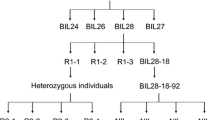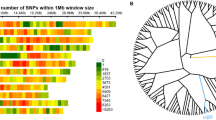Abstract
Panicle traits are the most important agronomic characters which directly relate to yield in rice. Panicle length (PL) being one of the major components of rice panicle structure is controlled by quantitative trait loci (QTLs). In our research, conducted at Research Farm of SKUAST-J, crosses of parental lines K 343 and DHMAS were made for generating \(\text {F}_{2}\) mapping population, which were then transplanted into the field using augmented design-I. The \(\text {F}_{2}\) population was used for phenotypic evaluation, development of linkage map and identification of QTLs on the chromosomes by using SSR markers. A total of 450 SSR markers were used for screening both the parents of which 53 highly polymorphic markers were selected and used for genotyping of 233 genotypes of \(\text {F}_{2}\) population. Linkage map was generated using MAPMAKER/EXP3.0 software, seven linkage groups were found distributed on 11 chromosomes of rice. QTLs were detected using QTL Cartographer (v2.5) software. Based on 1000 permutation tests, a logarithm of odds (LOD) threshold value 2.0 and 3.0 was set. Composite interval mapping was used to map QTLs in populations derived from bi-parental crosses. The phenotypic data, genotypic data and the genetic linkage map generated identified total three QTLs of which one was identified for PL qPL2, located at 85.01 cM position with 2.1 LOD value and in between the marker intervals RM324–RM208, this QTL explained the phenotype variation by 4.36%. The other two QTLs were identified for spikelet density (SD) qSD3.1 and qSD3.2, located at 28.91 and 39.51 cM, respectively, both with a flanking marker RM6832 on chromosome 3. The LOD value and phenotypic variation explained for qSD3.1 and qSD3.2 was 3.00 and 3.25; 9.70 and 12.34% respectively. The reported QTLs identified in the study suggested a less diversity in the parents used and also the rejection of not so useful markers from the used set of markers for PL and SD.






Similar content being viewed by others
References
Ahmadi J., Fotokian M. H. and Fabriki-Orang S. 2008 Detection of QTLs influencing panicle length, panicle grain number and panicle grain sterility in rice (O. sativa L.). J. Crop. Sci. Biotechnol. 11, 163–170.
Ando T., Yamamoto T., Shimizu T., Fang Ma X., Shomura A., Takeuchi Y. et al. 2008 Genetic dissection and pyramiding of quantitative traits for panicle architecture by using chromosomal segment substitution lines in rice. Theor. App. Gen. 116, 881–890.
Churchill G. A. and Doerge R. W. 1994 Empirical threshold values for quantitative trait mapping. Genetics 138, 963–971.
Davey M. W., Kenis K. and Keulemans J. 2006 Genetic control of fruit vitamin C contents. Plant Physiol. 142, 343–351.
Fu Q., Zhang P., Tan L., Zhu Z., Ma D. and Fu Y. 2010 Analysis of QTLs for yield-related traits in Yuanjiang common wild rice (Oryzarufipogon Griff.). J. Genet. Genomics 37, 147–157.
Gao F., Wen W., Liu J., Rasheed A., Yin G., Xia X. et al. 2015 Genome-wide linkage mapping of QTL for yield components, plant height and yield-related physiological traits in the Chinese wheat cross Zhou 8425B/Chinese Spring. Front Plant Sci. 6, 1099.
Gonzaga Z. J., Aslam K., Septiningsih E. M. and Collard B. C. 2015 Evaluation of SSR and SNP markers for molecular breeding in rice. Plant Breed. Biotechnol. 3, 139–152.
Hartman Y., Hooftman D. A. P., Schranz M. E. and Van Tienderen P. H. 2013 QTL analysis reveals the genetic architecture of domestication traits in crisphead lettuce. Genet. Res. Crops Evol. 60, 1487–1500.
Hittalmani S., Huang N., Courtois B., Venuprasad R., Shashidhar H. E. and Zhuang J. Y. 2003 Identification of QTL for growth and grain yield-related traits in rice across nine locations of Asia. Theor. Appl. Genet. 107, 679–690.
Khan S. A., Imran M. and Ashfaq M. 2009 Estimation of genetic variability and correlation for grain yield components in rice (Oryza sativa L.). Am.-Eura. J. Agric. Env. Sci. 6, 585–590.
Kumar J., Gupta D. S., Gupta S., Dubey S., Gupta P. and Kumar S. 2017 Quantitative trait loci from identification to exploitation for crop improvement. Plant Cell. Rep. 36, 1187–1213
Lander E. S., Green P., Abrahamson J., Barlow A., Daly M. J., Lincoln S. E. and Newburg L. 1987 Mapmaker: an interactive computer package for constructing primary genetic linkage maps of experimental and natural populations. Genomics 1, 174–181.
Lin H., Qian H., Zhuang J., Lu J., Min S. and Xiong Z. M. 1996 RFLP mapping of QTLs for yield and related characters in rice (Oryza sativa L.). Theor. Appl. Genet. 92, 920–927.
Liu E., Liu Y., Wu G., Zeng S., Thi T. G. T., Liang L. et al. 2016 Identification of a candidate gene for panicle length in rice (Oryza sativa L.) via association and linkage analysis. Front. Plant Sci. 7, 596.
McCouch S. R., Chen X., Panaud O., Temnykh S., Xu Y., Cho T. G. et al. 1997 Microsatellite marker development, mapping and applications in rice genetics and breeding. Plant Mol. Biol. 35, 89–99.
McCouch S. R., Temnykh S., Lukashova A., Coburn J., Declerck G., Cartinhour S. et al. 2001 Microsatellite markers in rice: abundance, diversity and applications. In Rice genetics IV, pp. 117–135. IRRI, Manila, Philippines.
McCouch S. R., Leonid T., Xu Y. B., Katarzyna B. L., Karen C., Mark W. et al. 2002 Development and mapping of 2240 new SSR markers for rice (Oryza sativa L). DNA Res. 9, 199–207.
Mohammadi R., Mendioro M., Diaz G. Q., Gregorio G. and Singh R. K. 2013 Mapping quantitative trait loci associated with yield and yield components under reproductive stage salinity stress in rice (Oryza sativa L.). J. Genet. 92, 433–443.
Navea I. P., Dwiyanti M. S., Park J., Kim B., Lee S., Huang X. et al. 2017 Identification of quantitative trait loci for panicle length and yield related traits under different water and P application conditions in tropical region in rice (Oryza sativa L.). Euphytica 213, 37.
Paterson A. H., Bowers J. E., Van de Peer Y. and Vandepoele K. 2005 Ancient duplication of cereal genomes. New Phytol. 165, 658–661.
Pinson S. R. M. and Jia Y. 2016 QTLs for early tiller production and relationships with rapid seedling growth and increased panicle number in rice. Crops Sci. 56, 505–519.
Rani N. S., Rao L. V. S. and Viraktamath B. C. 2006 National guidelines for the conduct of tests for distinctness, uniformity and stability: rice (Oryza sativa L) – zero draft, pp. 39. Directorate of Rice Research, Hyderabad.
Sasaki K., Fujita D., Koide Y., Lumanglas P. D., Gannaban R. B. et al. 2017 Fine mapping of a quantitative trait locus for spikelet number per panicle in a new plant type rice and evaluation of a near-isogenic line for grain productivity. J. Exp. Bot. 11, 2693–2703.
Seck P. A., Diagne A., Mohanty S. and Wopereis M. C. S. 2012 Crops that feed the world 7: rice. Food Sec. 4, 7–24.
Stephen E. L., Mark J. D. and Eric S. L. 1993 Constructing genetic linkage maps with MAPMAKER/EXP Version3.0, A Whitehead Institute for Biomedical Research technical report, 3rd edition. Whitehead Institute for Biomedical Research.
Takai T., Nakano H., Yoshinaga S. and Kondo M. 2018 Identification of a novel QTL for the number of spikelets per panicle using a cross between indica- and japonica-type high-yielding rice cultivars in Japan. Plant Breed. 137, 109–117.
Temnykh S., DeClerck G., Lukashova A., Lipovich L., Cartinhour S. and McCouch S. 2001 Computational and experimental analysis of microsatellites in rice (Oryza Sativa L.): frequency, length variation, transposon associations, and genetic marker potential. Gen. Res. 11, 1441–1452.
Wang S., Basten C. J. and Zeng Z. B. 2004 Windows QTL Cartographer 2.0. Department of Statistics, North Carolina State University, Raleigh.
Wang S., Basten C. J. and Zeng Z. B. 2007 Windows QTL cartographer 2.5. (http://statgen.ncsu.edu/qtlcart/WQTLCart.htm).
Xing Y. Z., Tan Y. F., Hua J. P., Sun X. L., Xu C. G. and Zhang Q. 2002 Characterization of the main effects, epistatic effects and their environmental interactions of QTLs on the genetic basis of yield traits in rice. Theor. Appl. Genet. 105, 248–257.
Yonemaru J. I., Yamamoto T., Fukuoka S., Uga Y., Hori K. and Yano M. 2010 Q-TARO: QTL annotation rice online database. Rice 3, 194–203.
Zhu Z., Li X., Wei Y., Guo S. and Sha A. 2018 Identification of a novel QTL for panicle length from wild rice (Oryza minuta) by specific locus amplified fragment sequencing and high density genetic mapping. Front. Plant Sci. 9, 1492.
Acknowledgements
The first author would like to thank the School of Biotechnology, Sher-e-Kashmir University of Agricultural Sciences and Technology of Jammu, Chatha, J&K for allowing the successful conduction of the research problem.
Author information
Authors and Affiliations
Corresponding author
Additional information
Corresponding editor: Manoj Prasad
Rights and permissions
About this article
Cite this article
Bhat, R., Singh, A.K., Salgotra, R.K. et al. Detection of QTL for panicle architecture in \(\hbox {F}_{2}\) population of rice. J Genet 98, 50 (2019). https://doi.org/10.1007/s12041-019-1088-z
Received:
Revised:
Accepted:
Published:
DOI: https://doi.org/10.1007/s12041-019-1088-z




